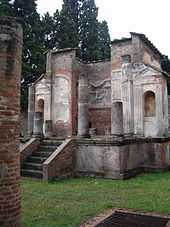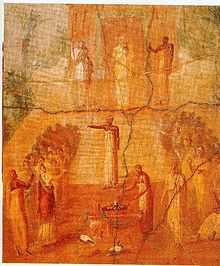Temple of Isis (Pompeii)
_-_Pompei_-_Tempio_d'Iside_-_n._5038_-_ca._1870.jpg)
The Temple of Isis is a Roman temple dedicated to the Egyptian goddess Isis. This small and almost intact temple was among one of the first discoveries during the excavation of Pompeii in 1764.[1] Its role as a Hellenized Egyptian temple in a Roman colony was fully confirmed with an inscription detailed by Francisco la Vega on July 20, 1765. Original paintings and sculptures can be seen at the Museo Archaeologico in Naples;[2] the site itself remains on the Via del Tempio di Iside. In the aftermath of the temple's discovery many well-known artists and illustrators swarmed to the site.[3]
The preserved Pompeian temple is actually the second structure; the original building built during the reign of Augustus was damaged in an earlier earthquake of 62 AD. Seventeen years later with the massive volcanic eruption, the Iseum alone was the sole temple to be completely re-built—ahead even of the Capitolium.[1] Although the Iseum was wedged into a small and narrow space, it received significant foot traffic from theater-goers at the Large Theater, businessmen in the Triangular Forum, and others along the Stabian Gate.[1]
Principal devotees of this temple are assumed to be women, freedmen, and slaves.[1] Initiates of the Isis mystery cult[4] worshipped a compassionate goddess who promised eventual salvation and a perpetual relationship throughout life and after death.[5] The temple itself was reconstructed in honor of a 6 year-old boy by his freedman father, Numerius, to allow the child to enter elite society.[1] Many scenes from the temple are re-created in the dining rooms of Pompeians, however, indicating that many individuals visited this temple for political, economic, or social reasons.[1]
Worship of Isis

Isis was a goddess in Ancient Egyptian religious beliefs, whose worship spread throughout the Greco-Roman world. She was worshipped as the ideal mother, wife, the matron of nature and magic. She was the friend of slaves, sinners, artisans, the downtrodden, who also listened to the prayers of the wealthy, maidens, aristocrats and rulers.[6] Isis worship was concerned about the acquisition of knowledge since knowledge could only be attained from the gifts of the gods.[7] Priests of Isis typically shaved their heads and wore linen garments rather than wool.[7] Isis worship did not include a Messianic worldview but it did provide a relationship with the divine that was not ruptured with death.[8] In common with other deities Isis did not demand exclusive worship but in practice her devotees applied, from a modern perspective, a henotheistic outlook.[9] The cult of Isis is thought to arrived in Pompeii around 100 BC Following the destruction of the first temple in the earthquake of 62 AD the son of Numerous paid for its complete reconstruction.[10] The setting and adornments provided an attractive backdrop for the liturgical rites.[10] These services occurred daily with a solemn morning opening and a nightly closing filled with singing.[5] A ritual bucket for holy Nile water, the situla, and a rattle, the sistrum, were both used in worship.[1]
Artwork

Egyptian features of this temple include: purgatorium, extensive mythological scenes in the Ekklesiasterion, and Egyptian signs within the sacraium.[1] The purgatorium is a roofless enclosure in the southeast corner of the courtyard that demarcates a subterranean room with a basin for Nile waters.[1] Furthermore, statues of Isis are assumed to line the front with Roman deities along the long walls. The purgatorium itself resembles a miniature temple with pediments and pilasters at the entrance coated with stucco.[1]
The Ekklesiasterion includes scenes of Io's arrival in Egypt and subsequent reception by Isis.[11] The north wall includes scenes with Io (mythology), Argos, and Hermes. This room itself appears to be the most formal with its role in ritual banquets as well as the reunion of initiates.[11] The sacraium is even more Egyptian with a mural of snakes guarding a wicker basket adorned with lunar symbols.[1] This may represent a spring sailing season celebration, navigium Isidis, since Isis restores her husband-brother to life by towing a boat filled with sacred waters.[1]
Mozart visit
The famous composer Wolfgang Amadeus Mozart is known to have visited the Temple of Isis at Pompeii in 1769, just a few years after it was unearthed and when Mozart was himself just 13 years old. His visit and the memories of the site are considered to have inspired him 20 years later in his composition of The Magic Flute.[12]
Notes
- ↑ 1.0 1.1 1.2 1.3 1.4 1.5 1.6 1.7 1.8 1.9 1.10 1.11 Hackworth Petersen, L. (2006). The Freedman in Roman Art and Art History. Cambridge University Press
- ↑ Tiberio Gracco. "Museo Archeologico Nazionale di Napoli - English language". Marketplace.it. Retrieved 2012-02-21.
- ↑ Nappo, p. 91.
- ↑ Antonio Virgili, Culti misterici ed orientali a Pompei, Gangemi, Roma, 2008
- ↑ 5.0 5.1 The Diaspora Cults. (1970) Ancient History XI, High Empire 2nd ed. Cambridge University Press.
- ↑ R.E Witt, "Isis in the Ancient World", p. 7, 1997, ISBN 0-8018-5642-6.
- ↑ 7.0 7.1 "Plutarch. "Isis and Osiris" from the Moralia, Book V. Available on". Penelope.uchicago.edu. Retrieved 2012-02-21.
- ↑ Cambridge, p955
- ↑ Cambridge, p1002
- ↑ 10.0 10.1 Nappo, p. 89.
- ↑ 11.0 11.1 Balch, D.L. (2003). The Suffering of Isis/Io and Paul's Portrait of Christ Crucified (Gal. 3:1): Frescoes in Pompeian and Roman Houses and in the Temple of Isis in Pompeii.
- ↑ "The magic flute", Matheus Franciscus & Maria Berk, p450, BRILL, 2004, ISBN 90-04-13099-3
References
- Balch, D.L. (2003). "The Suffering of Isis/Io and Paul's Portrait of Christ Crucified (Gal. 3:1): Frescoes in Pompeian and Roman Houses and in the Temple of Isis in Pompeii", The Journal of Religion, 83(1), 24-55.
- Brogi, Giacomo. (1870). "Tempio d'Iside", n5038, Wikimedia Commons.
- "Cambridge Ancient History XI, High Empire 2nd ed. The Diaspora Cults", (1970), Cambridge University Press.
- Dio, Cassius. "Roman History, Vol VIII", (1925), Re-published on penelope.uchicago.edu
- Hackworth Petersen, L. (2006). "The Freedman in Roman Art and Art History", Cambridge University Press.
- Nappo, Salvatore. "Pompey: Guide to the Lost City", White Star, 2000, ISBN 88-8095-530-6
- Plutarch. "Isis and Osiris" from the Moralia, Book V. Available on penelope.uchicago.edu
- Römischer, Gottesdienst. "Ehre Isis.". Wikimedia Commons
External links
| Wikimedia Commons has media related to Temple of Isis (Pompeii). |
- Photographs of exterior of temple along with many other photos of other Pompeiian ruins
- Photo of Io mural from the Ekklesiasterian
- Photos of Temple of Isis along with other Pompeiian ruins
- Image of Reconstruction of Temple of Isis
Coordinates: 40°44′57″N 14°29′17.8″E / 40.74917°N 14.488278°E
| ||||||||||||||||||||||||||||||||||||||